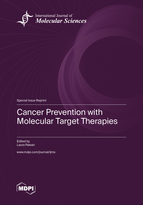Cancer Prevention with Molecular Target Therapies
A special issue of International Journal of Molecular Sciences (ISSN 1422-0067). This special issue belongs to the section "Molecular Oncology".
Deadline for manuscript submissions: closed (16 November 2020) | Viewed by 51645
Special Issue Editor
Interests: cancer prevention; molecular biology; drug repurposing; health technology assessment; pharmacoeconomics
Special Issues, Collections and Topics in MDPI journals
Special Issue Information
Dear Colleagues,
Personalized medicine is playing an important role in cancer prevention. To date, it is clear that many cancers are molecularly distinct subtypes, and different therapeutic approaches would be required for each. Indeed, the identification of cancer susceptibility genes permits identifying patients “at risk” of developing neoplasia and supports modifying individual risk behaviors or the choice of preventive therapy. Additionally, the efficacy of various targeted therapies in different cancer subtypes suggests that treatment choices in a near future will be more and more centered on molecular signatures. Data from preclinical, clinical, and observational studies have revealed the ability to prevent cancer development for compounds with different indications than cancer. The concept of drug repurposing permits combinations that can target several critical pathways of a specific disease, decreasing the risk of resistance observed when using single agent targeted therapy.
This open-access Special Issue will bring together original research and review articles on molecular oncology with attention to early detection and prevention of cancer. It highlights new findings, methods, and technical advances in molecular cancer research. The main feature of this Special Issue is to provide an open-source sharing of significant works in the field of molecular oncology that can increase our understanding of cancer development, which may lead to the discovery of new molecular diagnostic technologies and targeted therapeutics.
Topics include but are not limited to:
1—Molecular methods to personalize cancer screening and detection;
2—Molecular target therapies to prevent cancer development and metastases;
3—Identification and new aspects of cellular signaling molecules and pathways for target discovery, drug design, and personalized and gender medicine;
4—Drug repurposing for cancer prevention;
5—Molecular modeling studies.
Dr. Laura Paleari
Guest Editor
Manuscript Submission Information
Manuscripts should be submitted online at www.mdpi.com by registering and logging in to this website. Once you are registered, click here to go to the submission form. Manuscripts can be submitted until the deadline. All submissions that pass pre-check are peer-reviewed. Accepted papers will be published continuously in the journal (as soon as accepted) and will be listed together on the special issue website. Research articles, review articles as well as short communications are invited. For planned papers, a title and short abstract (about 100 words) can be sent to the Editorial Office for announcement on this website.
Submitted manuscripts should not have been published previously, nor be under consideration for publication elsewhere (except conference proceedings papers). All manuscripts are thoroughly refereed through a single-blind peer-review process. A guide for authors and other relevant information for submission of manuscripts is available on the Instructions for Authors page. International Journal of Molecular Sciences is an international peer-reviewed open access semimonthly journal published by MDPI.
Please visit the Instructions for Authors page before submitting a manuscript. There is an Article Processing Charge (APC) for publication in this open access journal. For details about the APC please see here. Submitted papers should be well formatted and use good English. Authors may use MDPI's English editing service prior to publication or during author revisions.
Keywords
- Cancer prevention
- Target therapy
- Personalized screening
- Drug repurposing
- Target discovery







